
Portal Guide
CHAPTER 3
This chapter explains how to use portal pages to personalize content in your portal applications. It covers the following topics:
Portal pages are customizable pages that you can include in Portal applications to present information tailored to your end-user audience. exteNd Director provides Web-based utilities for creating custom portal pages:
|
Name of utility |
Description |
Reference |
|---|---|---|
|
Portal Personalizer |
Lets any portal user create personal pages with personalized content and layout |
|
|
Portal Administration tool |
Lets portal administrators create: |
Chapter on Administering the Portal |
Each utility provides a graphical user interface to help you build portal pages using portlet technology with minimal if any Java programming required.
In addition, exteNd Director supplies a set of prebuilt portlets that provide out-of-the-box functions to add to your portal pages for rapid development and testing of application logic.
When you need to take a more specialized approach, you can develop your own portlets using the following tools:
 For more information about these tools see the chapter on developing portlets.
For more information about these tools see the chapter on developing portlets.
 For more information about portlets, see the chapter about portlets.
For more information about portlets, see the chapter about portlets.
exteNd Director supports several types of portal pages:
Because each type of page can be bound selectively to users and groups in an organization, portal pages are useful for building intranet sites and other portal applications that require personalized content.
When you view a portal page, you see content that is aggregated from your container page and the associated shared or personal page, as described in How content is determined for the current user.
Container pages and shared pages provide the mechanisms for branding all content in an organization with a standard look and feel.
Typically, portal administrators use container pages to brand—or wrap—personal pages and shared pages with a corporate identity and with controls for navigating the portal. exteNd Director provides several system portlets to support this functionality:
Page Navigation portlet can be added to a container page to automatically generate links to all pages the current user has permission to view—including personal pages, shared pages, and other container pages.
Portal Page Controller portlet designates where on the container page to display the content of a selected shared or personal page.
Page Header portlet renders custom headers on container pages and can be configured to also provide navigation links.
 For more information, see Working with Container pages and the chapter on system portlets for portal pages.
For more information, see Working with Container pages and the chapter on system portlets for portal pages.
Administrators use shared pages to disseminate content that is meant to be shared by specific users in an organization. For more information, see Working with Shared pages.
The portal administrator must define at least one container page for each portal application. exteNd Director ships with a container page and shared page, which are designated in web.xml as the portal's default pages, as follows:
<context-param> <param-name>PortalDefaultContainerPage</param-name> <param-value>DefaultContainerPage</param-value> <description>The name of the portal's default container page. A container page is the page he portal uses to display User and Shared pages.</description> </context-param> <context-param> <param-name>PortalDefaultSharedPage</param-name> <param-value>DefaultSharedPage</param-value> <description>The name of the default shared page.</description> </context-param>
As portal administrators create new container and shared pages, they can change these settings to designate their own pages as defaults for the portal.
Users can modify the default container and shared pages for their own portal sessions by using the Portal Personalizer tool, as described in the chapter on personalizing your portal.
IMPORTANT: As shipped, the default container and shared pages do not require authentication and, therefore, are available to all users. It is recommended that portal administrators NOT lock down or delete these default pages to ensure that all users are able to access the portal.
When you log in to the portal for the first time, you see a default portal page that aggregates the content of the default container page and default shared page.
Default portal page for administrators If you are a portal administrator or locksmith user, you'll see this default portal page when you first log in to the portal:
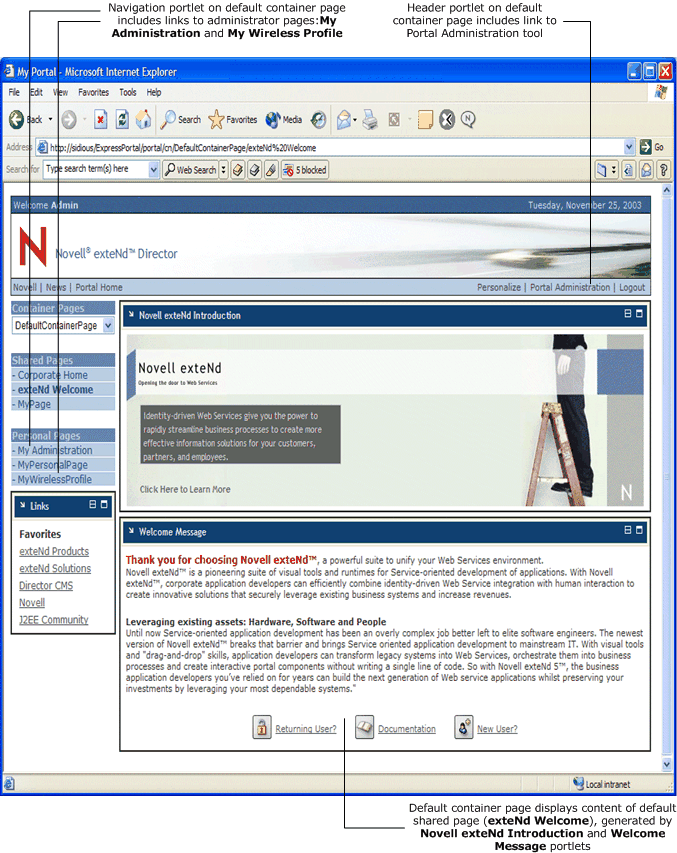
Note that the page includes content designed for portal administrators, including a link to the Portal Administration tool, a utility for creating container and shared pages described in the chapter titled administering the portal.
Default portal page for non-administrators If you are not a portal administrator or locksmith user, you'll see this default portal page when you first log in to the portal:
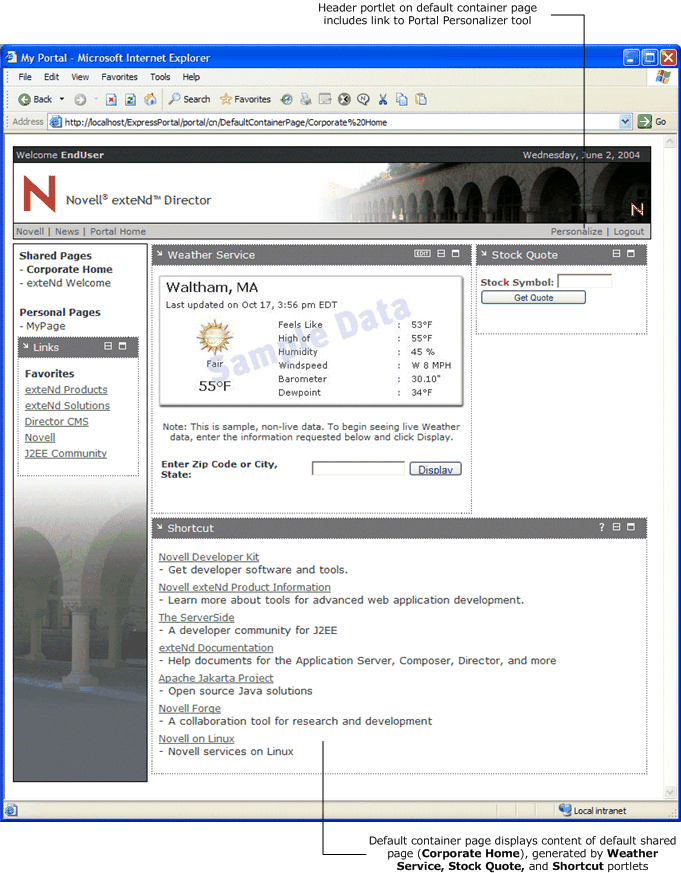
Note that the page includes content designed for users who are not administrators, including a link to the Portal Personalizer tool, a utility for creating personal pages (described in the chapter titled Personalizing Your Portal).
The exteNd Director Portal provides a Portal Aggregator to render content for the user in the current session. The content rendered is the aggregate of content from the user's container page, and associated personal or shared page.
For example, the following diagram shows how the Portal determines the content to display for a sample container page configuration:
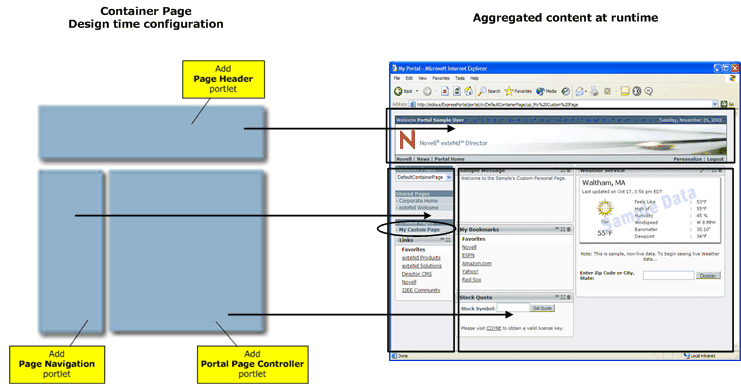
In this example, a portal administrator configures a container page with a Header-Navigation-Content layout and three system portlets:
When a user selects the link to My Personal Page from the navigation frame of this container page at runtime, a render request is generated. The Portal responds to the request by:
Determining the selected personal or shared page—in this case, My Custom Page
NOTE: My Custom Page contains four portlets: Sample Message, My Bookmarks, Stock Quote, and Weather Service.
Aggregating content as follows:
Gets the content generated by the Page Header portlet on the user's current container page and displays it in the Header frame
Gets the content generated by the Page Navigation portlet on the user's current container page and displays it in the Navigation frame
Gets the content generated by the portlets on My Personal Page and displays it via the Portal Page Controller portlet in the Content frame.
 To learn more about content aggregation logic, see Determining the container page and Determining the current shared or personal page.
To learn more about content aggregation logic, see Determining the container page and Determining the current shared or personal page.
When the user makes a request to the Portal, the Portal determines which container page should be displayed, using the following logic:
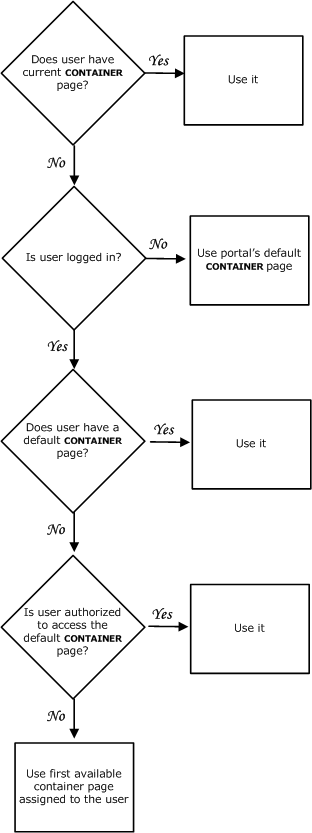
As the flow diagram shows, the Portal Aggregator checks for the following container pages:
|
Container page |
Description |
|---|---|
|
Current |
Container page selected by the user in the current session |
|
User default |
Default container page set by the user in the Portal Personalizer, as described in the chapter on personalizing your portal. |
|
First available |
First container page assigned to the user |
|
Portal default |
The default container page defined in your project's web.xml file as PortalDefaultContainerPage. Here is a sample descriptor: <context-param> <param-name>PortalDefaultContainerPage</param-name> <param-value>DefaultContainerPage</param-value> <description>Portal's default container page.</description> </context-param> |
After determining the container page for the current user, the Portal Aggregator uses the following logic to determine which shared or personal page to display in the content area of the container page:
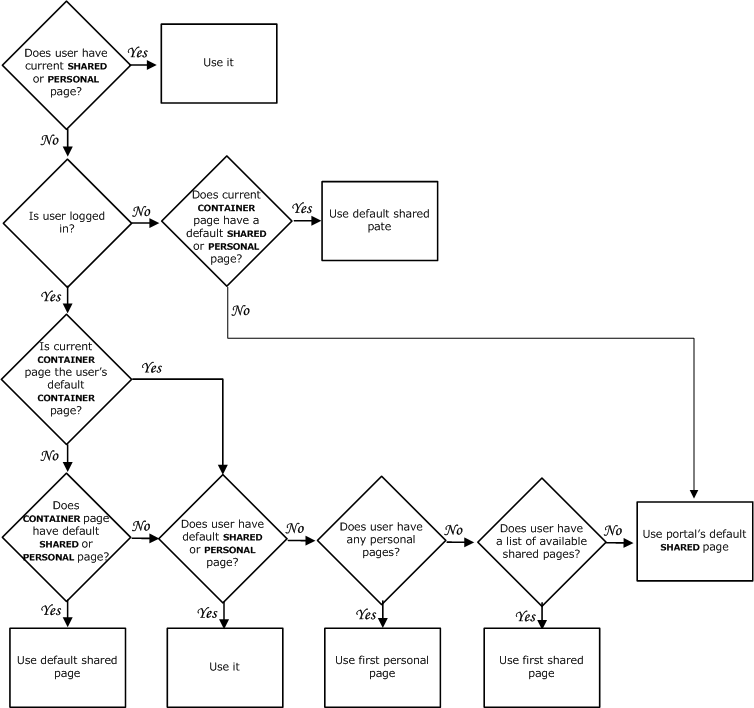
As the flow diagram shows, the Portal Aggregator checks for the following shared or personal pages:
|
Page |
Description |
|---|---|
|
Current |
Shared or personal page selected by the user in the current session |
|
User default |
Default shared or personal page set by the user in the Portal Personalizer, as described in Personalizing Your Portal. |
|
Container default |
Default shared page assigned to a container page by the portal administrator in the Portal Administration tool, as described in Administering the Portal. |
|
First available page |
First shared or personal page assigned to the user |
|
Portal default shared |
The default shared page defined in your project's web.xml file as PortalDefaultSharedPage. Here is a sample descriptor: <context-param> <param-name>PortalDefaultSharedPage</param-name> <param-value>DefaultSharedPage</param-value> <description>Portal's default shared page.</description> </context-param> |
Container pages are the conduits for displaying shared and personal pages with content suitable for particular groups of users. Administrators create container pages with images, logos, text, and navigation controls to brand the portal with a corporate identity.
Every portal application requires that at least one container page is defined. exteNd Director ships with a default container page, as described in Default container page.
Container pages must be defined by a portal administrator—that is, a user who is a member of the PortalAdmin group. The administrator uses the Portal Administration tool to:
Assign container pages to groups and users.
NOTE: The assignment gives users View permission only, allowing them to access container pages, but not modify them.
Container pages are not tightly bound to layouts. That means portal administrators can switch layouts for container pages without disrupting the page contents. When the administrator applies a new layout to a page, any previously selected portlets are automatically displayed using the new layout.
 To learn how to use the Portal Administration tool to create container pages, see the chapter on administering the portal.
To learn how to use the Portal Administration tool to create container pages, see the chapter on administering the portal.
The portal administrator can build container pages with system portlets supplied with exteNd Director or with custom portlets. System portlets provide the following out-of-the-box functions:
|
Container page function: |
Provided by: |
Required? |
|---|---|---|
|
Designate a content area |
Yes |
|
|
Navigate available pages in your portal |
No, but recommended |
|
|
Customize page headers |
No |
IMPORTANT: You must add one Portal Page Controller portlet to every container page to designate an area for displaying the content of shared pages or personal pages.
 For more information about these portlets, see System Portlets for Portal Pages.
For more information about these portlets, see System Portlets for Portal Pages.
The portal administrator must add one Portal Page Controller portlet to every container page to designate an area for displaying the content of a shared or personal page. If this portlet does not appear on a container page, the Portal cannot render the content of shared pages or personal pages on the container page.
 To learn how to add system portlets to container pages, see the chapter on administering the portal.
To learn how to add system portlets to container pages, see the chapter on administering the portal.
exteNd Director provides pre-built layouts that can be used on all portal pages. This section describes the layouts that are most commonly used for container pages. Portal administrators can change these layouts at any time without losing content.
 To learn how to apply page layouts, see the chapter on working with portal layouts.
To learn how to apply page layouts, see the chapter on working with portal layouts.
As its name suggests, the Header Nav Content layout provides header, navigation, and content frames. In addition to adding custom portlets to this layout, the portal administrator can add system portlets as follows:
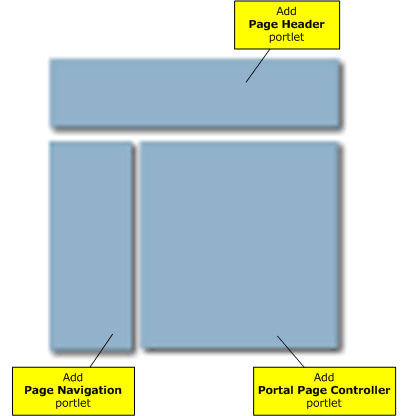
 For more information, see System Portlets for Portal Pages.
For more information, see System Portlets for Portal Pages.
The Header Content layout provides header and content frames. In addition to adding custom portlets to this layout, the portal administrator can add system portlets as follows:
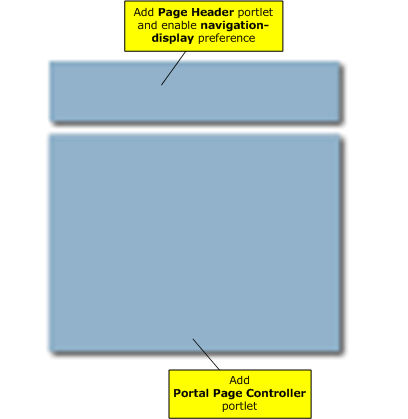
In this layout, you can enable navigation functionality in the Page Header portlet by setting its navigation-display preference to true.
 For more information, see System Portlets for Portal Pages.
For more information, see System Portlets for Portal Pages.
exteNd Director ships with a default container page. When you log in to the portal for the first time, the default container page is displayed:
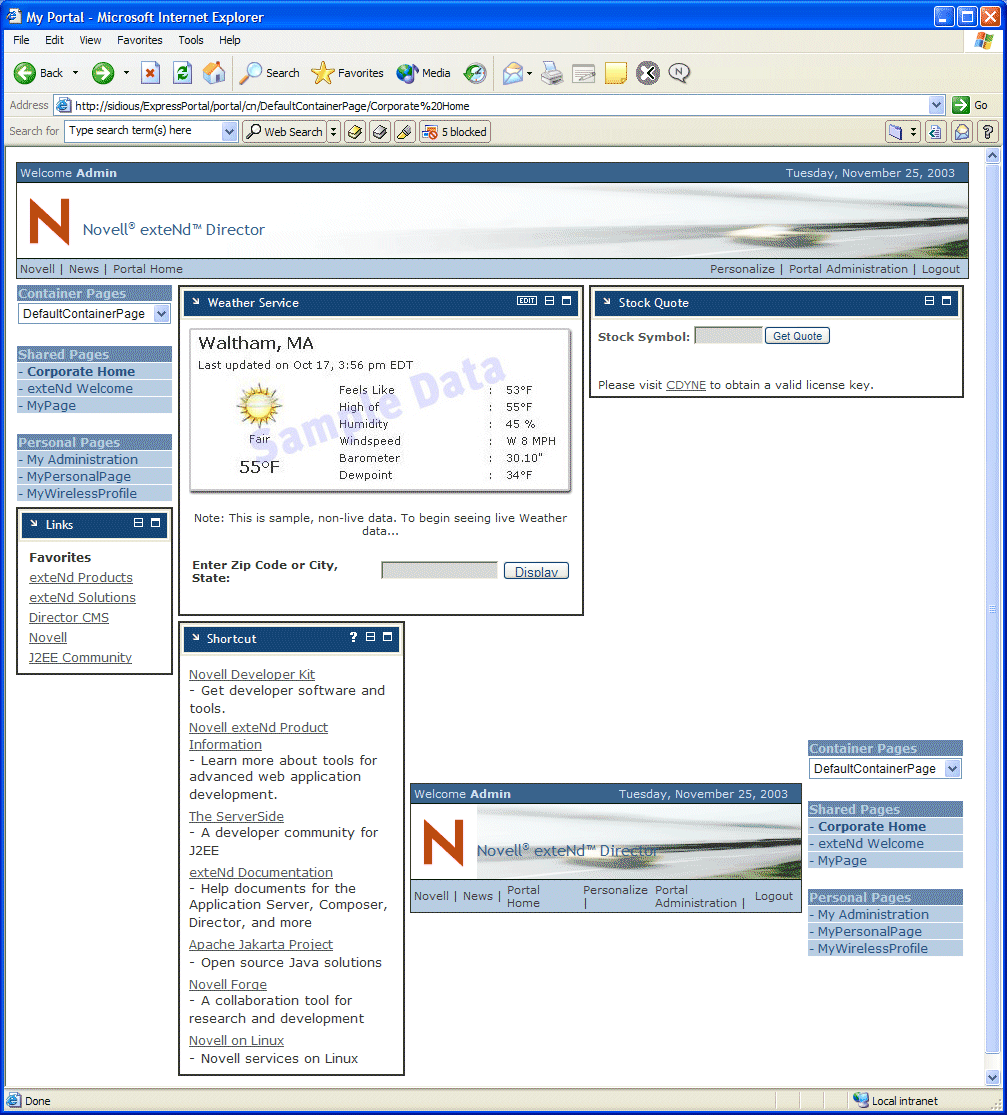
As you can see, the default container page displays the content of the default shared page Corporate Home in its content frame.
This page is designated in web.xml as the default container page for exteNd Director portal applications. Here is the descriptor:
<context-param> <param-name>PortalDefaultContainerPage</param-name> <param-value>DefaultContainerPage</param-value> <description>Portal's default container page.</description> </context-param>
The administrator can modify the contents and layout of the default container page and change the portal default by editing the PortalDefaultContainerPage parameter in the application's web.xml file.
Shared pages provide content to be shared by multiple users. Shared pages must be created by the portal administrator—that is, any user who belongs to the PortalAdmin group.
Shared pages are designed to work with container pages. Typically, a portal administrator creates container pages that provide links to the shared pages you are authorized to access and display the content of shared pages you select.
 For more information about how container pages work with shared pages, see How content is determined for the current user and Working with Container pages.
For more information about how container pages work with shared pages, see How content is determined for the current user and Working with Container pages.
The administrator uses the Portal Administration tool to specify the contents and layout of shared pages and to assign shared pages to users and groups. There are two types of permissions for shared page access:
|
Share page permission |
What it allows |
|---|---|
|
View |
User can access the shared page, but not modify its content or layout. |
|
Ownership |
User can access and modify the content and layout of the shared page. |
Shared pages are not tightly bound to layouts. That means page owners can switch layouts for their pages without disrupting the page contents. When the owner applies a new layout to a page, any previously selected portlets are automatically displayed using the new layout.
 For more information about using the Portal Administration tool for creating shared pages, see the chapter on administering the portal.
For more information about using the Portal Administration tool for creating shared pages, see the chapter on administering the portal.
The portal administrator can designate any number of users and/or groups as owners of a shared page. Owners can modify the content and layout of shared pages, and assign of shared pages to users and groups. When multiple owners make changes to a shared page, the last set of edits prevails.
Portal administrators and shared page owners can modify portlet preferences on shared pages using the Portal Administration tool, as described in the chapter on administering the portal.
At runtime, any user with access to a shared page can modify the preferences of portlet registrations that have been added to that page if:
The portlet developer has implemented Edit mode, either explicitly or using the default implementation, as described in the section on default implementation for Edit mode.
The portal administrator can use the Portal Administration tool to assign a parent page to any shared page. The parent must also be a shared page. When the Page Navigation portlet displays links to shared pages that have parents, the children appear indented under the parent page as a visual indicator of the relationship.
Child pages do not inherit content, preferences, or settings from their parent pages. Conversely, parent pages do not automatically display the content of child pages along with their own content.
Creating shared page hierarchies is helpful for grouping pages, especially when there are a large number of pages in the list of available shared pages.
NOTE: Portal administrators and locksmith users are authorized to access every shared page defined for a portal. Therefore, when logging in as the portal administrator or locksmith user, be aware that the number of available shared pages in a navigation or selection list will be extremely long.
 To learn how to assign parents to shared pages, see the chapter on administering the portal.
To learn how to assign parents to shared pages, see the chapter on administering the portal.
exteNd Director ships with a default shared page called Corporate Home:
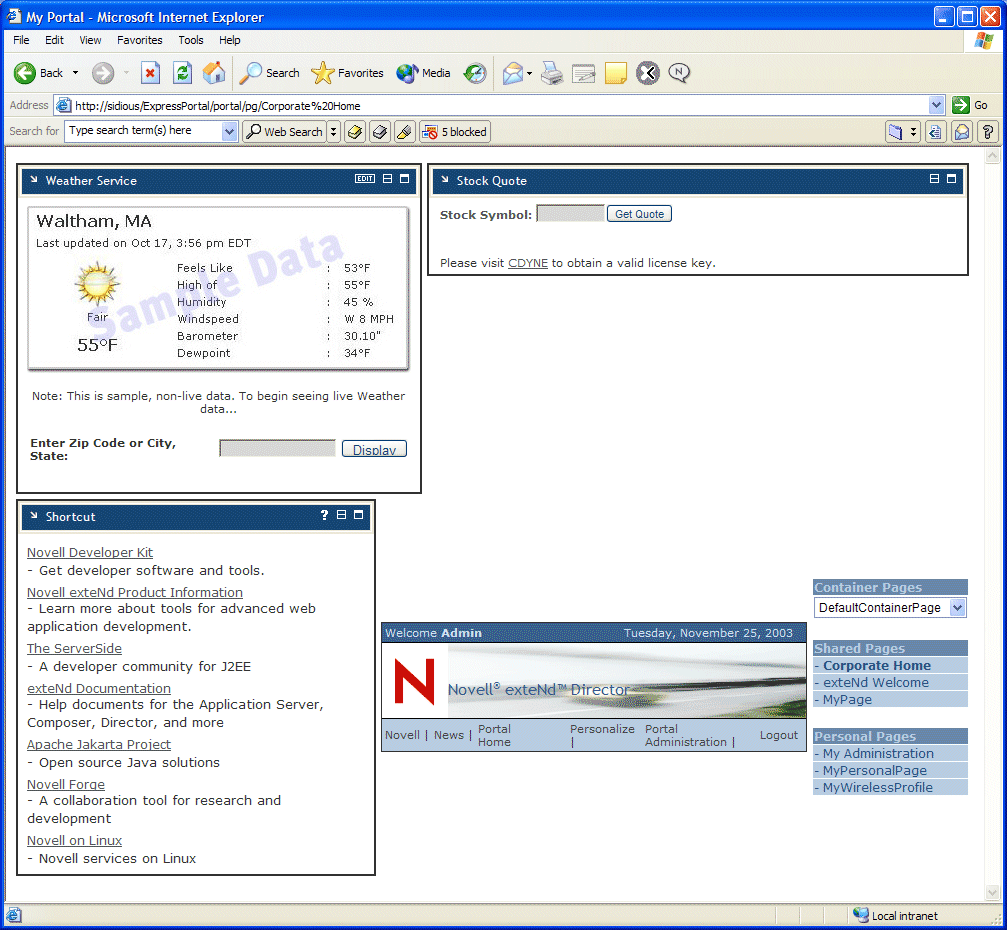
This page is designated in web.xml as the default shared page for exteNd Director portal applications. Here is the descriptor:
<context-param> <param-name>PortalDefaultSharedPage</param-name> <param-value>Corporate Home</param-value> <description>Portal's default shared page.</description> </context-param>
When you log in to the portal for the first time, the default shared page is displayed in the content area of the default container page. The administrator can modify the contents and layout of the default shared page and change the portal default by editing the PortalDefaultSharedPage parameter in the application's web.xml file.
Personal pages can be created by any portal user to show personalized content. Each personal page is private and can be accessed only by the creator. Portal users can create any number of personal pages by using the Portal Personalizer to specify page contents and layout. You can place multiple instances of any registered portlet on a single personal page.
 For complete details on using the Portal Personalizer to create personal pages, see the chapter on personalizing your portal.
For complete details on using the Portal Personalizer to create personal pages, see the chapter on personalizing your portal.
Personal pages are not tightly bound to layouts. That means users can switch layouts for their pages without disrupting the page contents. When the user applies a new layout to a page, any previously selected portlets are automatically displayed using the new layout.
exteNd Director provides URLs for accessing container pages, shared pages, and personal pages directly, and displaying them in your browser.
NOTE: Portal page URLs are case-sensitive.
You can use the following URL to access container pages on your server:
http://server/project context/portal/cn/container page name
For example, if your server is localhost and your project context is MyWAR, you can access the default container page by entering this URL in your browser:
http://localhost/MyWAR/portal/cn/DefaultContainerPage
The exteNd DirectorPortal responds to a container page URL request by displaying the aggregate of content from the requested container page along with content from the associated shared or personal page, as described in How content is determined for the current user.
You can instruct the Portal to display the content of a specific shared or personal page with your container page by using these URLs:
You can use the following URL to access shared pages on your server:
http://server/project context/portal/pg/shared page name
For example, if your server is localhost and your project context is MyWAR, you can access the default shared page by entering this URL in your browser:
http://localhost/MyWAR/portal/pg/DefaultSharedPage
You can use the following URL to access personal pages on your server:
http://server/project context/portal/pg/up_personal page name
For example, if your server is localhost and your project context is MyWAR, you can access a personal page called MyUserPage by entering this URL in your browser:
http://localhost/MyWAR/portal/pg/up_MyUserPage
The portal administrator can assign categories to shared and container pages to filter access to content within access control lists (ACLs). See Working with Page Categories.
Copyright © 2004 Novell, Inc. All rights reserved. Copyright © 1997, 1998, 1999, 2000, 2001, 2002, 2003 SilverStream Software, LLC. All rights reserved. more ...